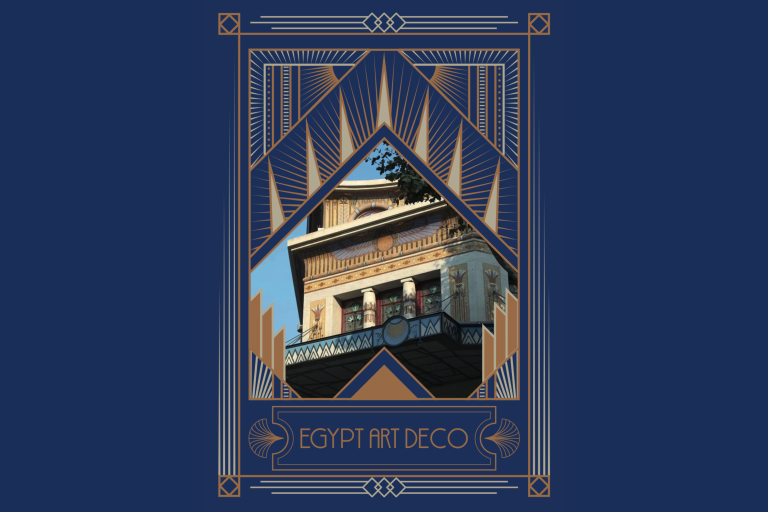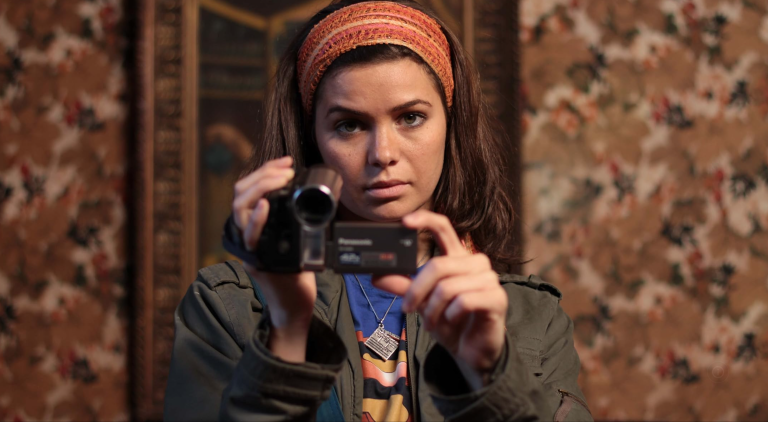Inside an abandoned theater, the clap doesn’t die. It transforms, stretching into a twenty-three-second reverb that refuses to let go.
I met artist Firas El Hallak here on a Friday in August, his presence quiet in the ruin’s heavy heat.
Dressed in black, sunglasses and cap pulled low, he moved through the ruin with childlike wonder. His voice was quiet but threaded with humor, as if trying to lighten the dome’s heavy heat.
Outside, in Tripoli, Lebanon’s second-largest city that’s pressed against the Mediterranean, traffic tangled with market shouts.
Expats and tourists poured back after last year’s war with Israel, which left more than 4,000 Lebanese dead and an estimated $20 billion in destruction– a reminder of how easily places can vanish.
From a nearby mosque, the afternoon call to prayer spilled across the fairgrounds, over gardens gone wild, before dissolving into the sound of worshippers gathering inside.
Stepping into the dome, the light collapsed behind us, and what lingered was Firas’s voice, reverberating through the ruin. The vast concrete shell swallowed sound and sight alike. Metal stringers dangled like torn veins from the ceiling. Circular steps traced the curve of the structure, their edges chipped and crumbling. At the back, a staircase slipped into shadow, leading toward half-finished rooms once meant to hold life backstage.
This ruin is the heart of his project, The Dome Sessions, twelve site-specific musical performances that transform abandoned architecture into both instrument and archive. The 23-second reverberation carrying each note like a chorus of ghosts answering back.
He had flown in from Belgium, where he moved five years ago, drawn back on this yearly pilgrimage to release this musical record, which was a decade in the making.

“Most of my work,” he told me, “gravitates around spaces—abandoned spaces, cities, the traces they leave behind.” That impulse, he admitted, was rooted in loss.
Art, for him, was never meant to be consumed quickly. He described it through an image that stayed with me: a refined dog staring at a treat, trembling with urgency yet, unable to reach for it. What endures when everything else is gone?
Firas grew up here in Tripoli, in the shadow of Lebanon’s fifteen-year civil war, where once it was over the warlords simply stepped into government offices. Memory, in such a place, was as breakable as glass. With no trials and no reckoning, forgetting became the only way forward for the older generations. He resists that act of forgetting by archiving sound.
Firas told me about the “firsts” that stitched his adolescence to these grounds. The first time he wandered in, terrified of jinn stories and ghost tales, convinced for a while they were extraterrestrial and that salvation might come from above. The first time he pushed past his fear and stepped into the shadows of the dome.The first beer he shared with friends. The first time he was stopped by authorities for trespassing.
The fairground itself had been meant for another future.
In the 1960s, Lebanon invited the Brazilian architect Oscar Niemeyer to design an international exposition site that would place Tripoli at the center of the region. He drew up plans for exhibition halls, an experimental theater, sweeping gardens, and a dome that would amplify music into the sky. A vision of cosmopolitan promise, a country imagining itself as a crossroads.
But in 1975, when the civil war began, construction stopped overnight. The gates never opened. Militias moved in soon after, turning half-built pavilions into barracks and the lawns into trenches. Hundreds were killed. One wall, locals still whisper, was used for executions.
What remains now is a skeleton: unfinished concrete shells rising out of jasmine-filled gardens, structures with a strangeness that looks almost alien. Children still slip through the fences, looking for adventure.
For Lebanon, the fairgrounds stand as a monument to failure. For Firas, they became something else: an archive of sound, a collaborator in memory.

It was also where he first began to process the loss of his mother at a young age—an absence that shaped him, and one he has been mining ever since.
“I know I come from her, yet I know almost nothing about her.”
That gap became a mission: to rescue what slips away.
The Dome Sessions itself was born of a nightmare—a vision he once had of the great dome collapsing before anyone had heard it.
“That nightmare pushed me to finish,” he said. “In my work, death is a vital drive.”
Standing there with Firas, a colony of bats stirred above us, their wings stitched into the rafters. The ghosts felt impossible to ignore.
The creatures had made this ruin their home, their cries threading through some of The Dome Sessions’ performances, like uninvited collaborators.
At the bottom of the stairs, Firas pointed toward a pool that no longer exists, where, he said, a Syrian soldier once tried to dive, not knowing the water was too shallow. The man hit the ground and died.
There is no record of him, no obituary.
By staging performances inside the dome, Firas wasn’t just experimenting with acoustics. He was forcing sound to collide with memory. The Dome Sessions, he says, is an archive against erasure, an act of undoing disappearance.
Musicians step into the raw circle of concrete in the center of the structure; the audience gathers along the edges, and the building itself takes over.
In one performance, a drumbeat detonates and ricochets until it feels like thunder rolling back from the mountains. Strings unravel into spirals. Sandy Chamoun’s voice cracks open against the walls, multiplying into something raw and transcendent, a hymn dragged from another time.
In a solo performance, musician Julia Sabra’s guitar cuts differently, sharp then dissolving, her voice suspended in the air so long it feels like the dome itself is holding its breath.
All the musicians who entered the dome had lived through Lebanon’s recent unraveling: a sudden financial collapse that swallowed their savings, street uprisings that thundered but yielded no change, years of paralysis without a government, the largest non-nuclear explosion in history, and most recently, a 60 day war with Israel that reduced entire villages in the south to dust.

This unraveling was also why so many young people left the country, including Firas. For him, departure was less choice than survival.
“Being away gave me perspective I wouldn’t have had in daily life in Lebanon,” he told me. “I can see patterns more clearly—but I also carry absence, even guilt. The weight of crises makes long-term work almost impossible. Distance gave me the space to finish.”
Sitting on the steps inside the empty dome, I asked Firas to play back the performance that had stayed with me most. On his phone, the Tripoli church choir rose again, gathered in this ruin to sing Fairouz’s “Zahrat al-Mada’in,” her enduring hymn to Jerusalem. He had chosen it deliberately.
Tripoli, he said, always reminded him of Jerusalem, a city of reverence and ruin, burdened by memory, and by loss, and resistance.
As the song rose into the dome like a prayer, I recalled a stack of family photographs that Firas had shared with me, the beginnings of his archival journey. One of the photos was of his mother, Jamal el Hajj, in her Russian dorm room in the late 1970s: a red plaid dress, dark hair, leaning against floral wallpaper.
Another was a postcard from his uncle, inscribed with a haunting poem. I recalled this verse: “Sadness taught him that stillness is suicide, that departure is destiny.”
Jamal was a proud Palestinian born in exile, who died before ever having the chance to return.
The family’s village of Al-Bassa, on the outskirts of Akka, was once a cluster of stone houses surrounded by olive and fig trees, with mosques, churches, and athletic clubs. In 1948, the city was ethnically cleansed by Zionist militias, and still remains in ruins until today.
The hymn to Jerusalem seemed to carry her too.
After listening to the full album, I understood that no one enters the dome untouched. Firas imagined it as a space where absence could be a shared presence, where sound might carry what words cannot. Where people can come together to heal. To step inside is to arrive with questions. How do we recount stories of ruin from within the ruins themselves?
Fragility, Firas suggested, is the only constant.
“Much of my work reflects on the natural course of history, which inevitably turns everything into rubble, whether by time or by war. What I am trying to build is an archive of a present already in decay.”
Listening to him speak, I began to understand why I was drawn here too. As a Palestinian with roots from Gaza who has only been able to report on the destruction from afar, I found his project gave form to questions I carry but cannot resolve. How do you bear witness to ruins you cannot touch, to grief you cannot gather with your own hands?
Before we left, Firas clapped once more. The sound ricocheted off the dome’s ribs, held for twenty-three seconds, then returned heavier, as if carrying all who had passed through.
The Dome Sessions live on as a record, but as long as this experimental theater still stands, its echo will wait, restless, for someone to listen back.














Trump’s Gaza Plan Mustn’t Follow His Record on Women’s Rights
Trump’s 20-points Gaza peace plan shouldn’t repeat his domestic failures on women’s health, education, and rights.